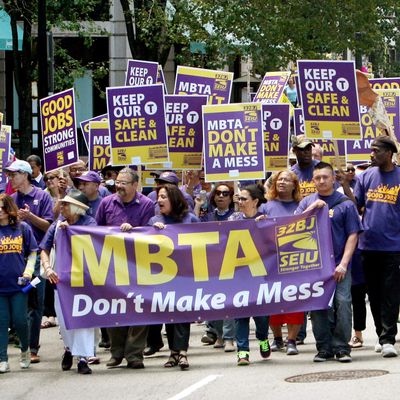
Labor advocates, who have gotten used to bad news over the last several decades, were expecting a big blow from the Supreme Court today. On the docket was Harris v. Quinn, a case that asked the Court to examine the most fundamental assumptions about union membership. If it went badly, the case could have seriously endangered public-sector unions like the SEIU, by allowing members to opt out of paying collective bargaining fees.
The Court’s decision, penned by Justice Alito on behalf of the Court’s conservative wing, wasn’t kind to public-sector unions, but it could have been much, much worse. The Court ruled 5–4 that certain classes of public employees can opt out of paying collective bargaining fees, but stopped short of extending its decision to all public employees. Unions won’t be happy with the decision, but they’ve been spared the worst.
At its core, Harris v. Quinn was about whether public-sector unions can compel workers who benefit from their advocacy to pay their fair share of the costs associated with collective bargaining, even if those workers don’t like the union. The case was brought by a group of Illinois home-health-care workers who are paid by the state to care for Medicaid patients. Those personal assistants, as they’re called, objected on First Amendment grounds to being forced to pay collective bargaining fees to their union, SEIU Healthcare Illinois & Indiana.
Unions were scared that the Court would issue a wide ruling that would reverse a 1977 case, Abood v. Detroit Board of Education, which established a union’s right to force covered workers to share in the costs of that union’s operations. The reasoning for Abood was that unless unions could compel covered workers to pay for collective bargaining, workers would be able to freeload, reaping the benefits of the union’s efforts without having to contribute to the cause.
In today’s Harris v. Quinn decision, the Court’s majority essentially punted on the broader issue and issued an unexpectedly narrow ruling. Because of their unique working arrangements, these workers, the majority found, are essentially employed by the Medicaid patients they care for, not the state itself. Although they are paid out of public funds, they can’t be hired or fired by the state, and the state’s role in their relationship with the patient is minimal. Therefore, these assistants aren’t “full public employees” and aren’t covered by the earlier Abood decision, Justice Alito wrote:
Abood itself has clear boundaries; it applies to public employees. Extending those boundaries to encompass partial-public employees, quasi-public employees, or simply private employees would invite problems.
The Court’s liberal wing, led by Justice Kagan, disagreed, pointing out that although the home-care arrangements of the Illinois assistants aren’t typical, they still function like public employee contracts in important ways:
Although a customer can manage his own relationship with a caregiver, Illinois has sole authority over every workforce-wide term and condition of the assistants’ employment — in other words, the issues most likely to be the subject of collective bargaining.
Pro-labor progressives will likely see Harris v. Quinn as the top of a slippery slope. After all, if one group of public employees can petition to be excluded from their union requirements, others will surely try. Defining “partial-public employees” for the purposes of collective bargaining exclusion is a dangerous game — one that could lead to labor’s nightmare scenario, the redefinition of most public-sector unions as optional, opt-in endeavors, rather than organizations that represent the collective interests of a covered group.
But these fears are largely unfounded for now. Today, the Court decided that teachers, firefighters, and other traditional public employees will still be covered by the collective bargaining laws that have existed since the 1970s. Public employees with unusual, state-backed working arrangements, like the 20,000 personal care workers in Illinois, may not be. The Court’s narrow ruling is an annoyance for the labor movement, but hardly a cataclysm.





























